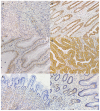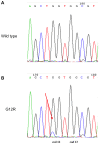EGFR, HER-2 and KRAS in canine gastric epithelial tumors: a potential human model?
- PMID: 24454858
- PMCID: PMC3893207
- DOI: 10.1371/journal.pone.0085388
EGFR, HER-2 and KRAS in canine gastric epithelial tumors: a potential human model?
Erratum in
-
Correction: EGFR, HER-2 and KRAS in canine gastric epithelial tumors: a potential human model?PLoS One. 2015 Mar 5;10(3):e0119048. doi: 10.1371/journal.pone.0119048. eCollection 2015. PLoS One. 2015. PMID: 25742303 Free PMC article. No abstract available.
Abstract
Epidermal growth factor receptor (EGFR or HER-1) and its analog c-erbB-2 (HER-2) are protein tyrosine kinases correlated with prognosis and response to therapy in a variety of human cancers. KRAS mediates the transduction of signals between EGFR and the nucleus, and its mutation has been identified as a predictor of resistance to anti-EGFR drugs. In human oncology, the importance of the EGFR/HER-2/KRAS signalling pathway in gastric cancer is well established, and HER-2 testing is required before initiating therapy. Conversely, this pathway has never been investigated in canine gastric tumours. A total of 19 canine gastric epithelial neoplasms (5 adenomas and 14 carcinomas) were retrospectively evaluated for EGFR/HER-2 immunohistochemical expression and KRAS mutational status. Five (35.7%) carcinomas were classified as intestinal-type and 9 (64.3%) as diffuse-type. EGFR was overexpressed (≥ 1+) in 8 (42.1%) cases and HER-2 (3+) in 11 (57.9%) cases, regardless of tumour location or biological behaviour. The percentage of EGFR-positive tumours was significantly higher in the intestinal-type (80%) than in the diffuse-type (11.1%, p = 0.023). KRAS gene was wild type in 18 cases, whereas one mucinous carcinoma harboured a point mutation at codon 12 (G12R). EGFR and HER-2 may be promising prognostic and therapeutic targets in canine gastric epithelial neoplasms. The potential presence of KRAS mutation should be taken into account as a possible mechanism of drug resistance. Further studies are necessary to evaluate the role of dog as a model for human gastric cancer.
Conflict of interest statement
Figures


Similar articles
-
In vitro and in vivo antitumor activity of cetuximab in human gastric cancer cell lines in relation to epidermal growth factor receptor (EGFR) expression and mutational phenotype.Gastric Cancer. 2012 Jul;15(3):252-64. doi: 10.1007/s10120-011-0102-9. Epub 2011 Oct 20. Gastric Cancer. 2012. PMID: 22011788
-
KRAS mutations in microsatellite instable gastric tumours: impact of targeted treatment and intratumoural heterogeneity.Virchows Arch. 2015 Oct;467(4):383-92. doi: 10.1007/s00428-015-1823-7. Epub 2015 Aug 29. Virchows Arch. 2015. PMID: 26318594
-
Biomarkers of benefit from cetuximab-based therapy in metastatic colorectal cancer: interaction of EGFR ligand expression with RAS/RAF, PIK3CA genotypes.BMC Cancer. 2013 Feb 2;13:49. doi: 10.1186/1471-2407-13-49. BMC Cancer. 2013. PMID: 23374602 Free PMC article.
-
The treatment of colorectal carcinoma with monoclonal antibodies: the importance of KRAS mutation analysis and EGFR status.Dtsch Arztebl Int. 2009 Mar;106(12):202-6. doi: 10.3238/arztebl.2009.0202. Epub 2009 Mar 20. Dtsch Arztebl Int. 2009. PMID: 19471640 Free PMC article. Review.
-
Los receptores epidérmicos humanos en el cáncer gástrico: alteraciones moleculares y su papel como diana terapéutica.Gac Med Mex. 2017;153(7):830-840. doi: 10.24875/GMM.17002748. Gac Med Mex. 2017. PMID: 29414960 Review.
Cited by
-
Immunohistochemical Expression of Human Epidermal Growth Factor Receptor 2 and Ki67 in Apocrine Gland Anal Sac Adenocarcinoma.Int J Mol Sci. 2024 Jun 12;25(12):6451. doi: 10.3390/ijms25126451. Int J Mol Sci. 2024. PMID: 38928157 Free PMC article.
-
The Role of Canine Models of Human Cancer: Overcoming Drug Resistance Through a Transdisciplinary "One Health, One Medicine" Approach.Cancers (Basel). 2025 Jun 17;17(12):2025. doi: 10.3390/cancers17122025. Cancers (Basel). 2025. PMID: 40563676 Free PMC article. Review.
-
Transcriptome Signatures of Canine Mammary Gland Tumors and Its Comparison to Human Breast Cancers.Cancers (Basel). 2018 Sep 7;10(9):317. doi: 10.3390/cancers10090317. Cancers (Basel). 2018. PMID: 30205506 Free PMC article.
-
Canine non-B, non-T NK lymphocytes have a potential antibody-dependent cellular cytotoxicity function against antibody-coated tumor cells.BMC Vet Res. 2019 Oct 14;15(1):339. doi: 10.1186/s12917-019-2068-5. BMC Vet Res. 2019. PMID: 31610784 Free PMC article.
-
Immunoexpression of Trefoil Factor 1 in Non-Neoplastic and Neoplastic Canine Gastric Tissues.Animals (Basel). 2021 Sep 29;11(10):2855. doi: 10.3390/ani11102855. Animals (Basel). 2021. PMID: 34679875 Free PMC article.
References
-
- Withrow SJ (2007) Cancer of the gastrointestinal tract. In: Withrow SJ, Wail DM. Withrow and MacEwen’s Small Animal Clinical Oncology. 4th edition. St. Louis, Missouri: Elsevier Saunders. 480–482.
-
- Swann HM, Holt DE (2002) Canine gastric adenocarcinoma and leiomyosarcoma: a retrospective study of 21 cases (1986–1999) and literature review. J Am Anim Hosp Assoc 38: 157–164. - PubMed
-
- Patnaik AK, Hurvitz AI, Jhonson G (1978) Canine gastric adenocarcinoma. Vet Pathol 15: 600–607. - PubMed
-
- Sullivan M, Lee R, Fisher EW, Nash AS, McCandlish IA (1987) A study of 31 cases of gastric carcinoma in dogs. Vet Rec 120: 79–83. - PubMed
-
- Scanziani E, Giusti AM, Gualtieri M, Fonda D (1991) Gastric Carcinoma in the Belgian shepherd dog. J Small Anim Pract 32: 465–469.
MeSH terms
Substances
LinkOut - more resources
Full Text Sources
Other Literature Sources
Medical
Research Materials
Miscellaneous

